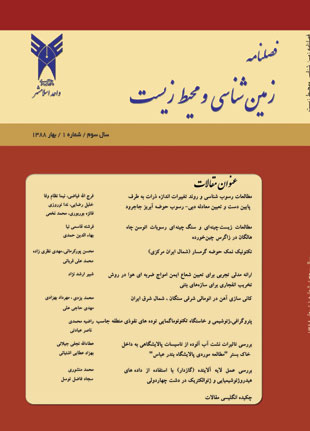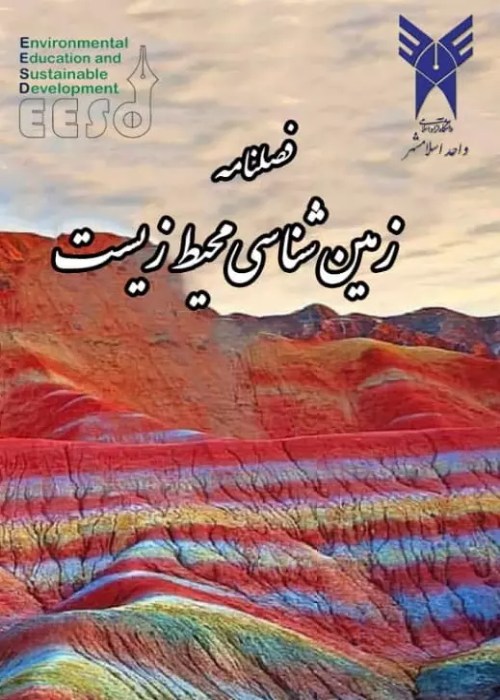فهرست مطالب

نشریه زمین شناسی محیط زیست
پیاپی 6 (بهار 1388)
- تاریخ انتشار: 1388/02/02
- تعداد عناوین: 8
-
Page 1Filling sediments behind dams decrease their useful lifetime, so sedimentological investigations in bed of arriving rivers are very necessary for distinguish and determination of sediment producer sources of sediments. Latian dam and Jajroud river have a critical situation. Jajroud drainage basin has an extent about 710 km2. It is located in north east of Tehran. It has 7 sub basins include Fasham, Ahar, Meigoon, Lavarak, Emameh, Kond and Afjeh. Its shape is nearly ellipsoid from NW to SE. This braided river has gravely bed with single channel and dam parameter more than 1. Average slope of Jajroud river is 4 percent. This river flows on bicarbonate, silicate, calcium bicarbonate, sulfate and salt material as bed rocks. The size of bed sediments has very irregular changes due to specialized tectonic activities in this area, arriving minor branches, clastic inputs, and changes in slope. So density of drainage in this river is 1.6. Most of sedimentary bars in Jajroud river are longitude and they show shallow and claim conditions. Morphoscopy of grains doesn’t have any defined trend. Granulometric graphs are polymodal. Sorting of grains are bad mostly. The graphs of mean and median changes have not regular trend. Most of samples have negative skewness and they are platykortic. Branch coefficient of this basin is 3.081, so this basin is general basin. The hydrograph curve of flood is normal. Final model for Debi- sediment for Jajroud basin has calculated based on physiography factors of basin that is correlated in maximum of Debi and flooding sediments by power ministry of Iran.Keywords: Jajroud, Sedimentology, Debi, Flood
-
Page 21In order to study and inspect of biostratigraphy and lithostratigraphy of Eocene sediments of Halegan well in folded zagros 100 thin microscopic sections of this well’s samples was studied. Mentioned studies caused to recognize 12 genus and 25 species of Planktonic foraminifera. According to spread stratigraphy planktonic foraminifera 3 Biozone (P6, P13, P16/P17) that separated and introduced for Eocene sediments in this well by D.Verga & R.Rettori (2003). Subsurface of section stratigraphy is compared with wynd Biozons (wynd,1965). According to recognized and separated biozons, Wynd biozonation is included 45, 47, 50. In this essay Pabdeh formation in Halegan well was introduced and compared both D,Verga & R.Rettori (2003) and Wynd (1965) Biozone. Results of comparison reveals that the best zonation for Pabdeh formation in Halegan well is D.Verga & R.Rettori (2003) Biozone.Pabdeh formathion is included a sequence of shale, marl, argillaceous limestone layers and their colors are usually gray, withe-brown in Halegan well. Pabdeh formation had been formed high depth of sea. It is an evidence for depth of zone in this area in Eocene period. According to this studies it seems Halegan well had been full of water in Eocene period the most onlap of sea had been in this period.Keywords: Pabdeh formation, Planktonic foraminifera, Lithostratigraphy, Biostratigraphy
-
Page 39Evaporate basin of North and West of Garmsar, tectonically is an east-west graben that located in the north border of central Iran back-arc basin. Garmsar fault as the most important tectonic structure of the studied area, trending east-west, is accommodated in north of Garmsar which declines towards the west and its trend changes to NW-SE. The mentioned fault is a thrust dipping to the north with left lateral attitude. Considering fracture system of salt structures in the studied area implies on influencing E-W structural trend of Garmsar thrust on salt structures. Garmsar thrust as the principle structure has the most important role in upwards movement of upper Eocene-Oligocene salt mass and taking them to the surface. Outcropped evaporate system imply existing a salt nappe aquifer in north of central Iran.Keywords: Garmsar thrust fault, salt structure, nappe, open toe, allochthonous salt sheets
-
Page 51One of the new engineering techniques in the world is demolition by controlled blasting operation. The method contains some mining and civil engineering’s techniques. They are the controlled blasting, proper selection of type and amount of explosives, air-blast, ground vibrations and fly rock effects and structure analysis, construction material properties, like mechanical strength of them. This paper has subjected to control of air-blast in concrete structures. Sometimes intensity of air-blast can due to fragment of windows and weak members of structures in faraway, if there are strong winds and inversion. It is clear that control of air-blast is very important; therefore four standards (USA, UK, Australia & Spain) for determining of allowable sound levels have collected in the paper. Authors made 22 concrete columns and three blast holes were drilled in each column. The hole spacings have selected independently. It means that blast of a hole does not affect the on other holes. After each blasting, sound level in dB (A), distance and amount of explosives in each period have recorded. Finally, the data were converted to logarithmical form and analyzed by multiple regressions and was obtained an empirical model. Correlation coefficient of the model shows that the model’s results are good agreement with empirical data. The model can evaluates safety radius against to airblast in demolition operation of concrete structures.Keywords: Blasting demolition, Air, Blast, Concrete structure, Experimental model
-
Page 65The Sangan iron deposit is composed of Western, Central and Eastern anomaly. The Eastern anomaly, contrary to those two other anomalies, is composed of several scattered mineralization outcrops with low total reserve. Sarnowsar is the main intrusive body that has been intruded in to the north of Eastern anomaly of Sangan iron deposit. It has monzogranitic composition. Mineralogical and chemical properties of this monzogranite is I-type, calk-alkaline with high K. It belongs to magmatic continental arc setting and subduction zones. The Fe mineralization in this area is related to Eocene- Oligocene magmatism and its magmatic and hydrothermal fluids. In the Eastern Anomaly, two types of mineralization were distinguished: 1- the magnetite skarn mineralization (high temperature) in the contact of granite and limestone or dolomitic limestone, 2- wellastonite, chlorite, hematite and goethite hydrothermal mineralization (low temperature) with or without barite mineralization within dolomitic limestone, calcareous sandstone and acidic volcanic rocks. In the first type, magnetite with minor pyrite and chalcopyrite as well as gangue minerals such as forsterite, garnet, clinopyroxene, tremolite-actinolite, scapolite, phlogopite, epidote, chlorite, quartz and carbonate have been observed in the forms of massive, lens-like (parallel with limestone layers), lamination and vein-type. In the second type, mineralization has been occurred in the form of irregular massive (centimeters to meters), replacement, disseminated, void and breccias matrix filling, vein, veinlet and stockwork, depending on the wall rock type and area structures. They are accompanied with alterations such as dolomitization, silicification, sericitization, carbonatization and rarely toumalinization.Keywords: Skarn, hydrothermal Fe, mineralization, Eastern anomaly, Sangan ore deposit
-
Page 81The Jasb area is located about 100 Km of South of Qom in Urmiyeh-Dokhtar magmatic belt. The scattered plutonic rocks belong to Eocene-Oligocene and Miocene. The plutonic rocks’ type Variations are granite, quartzmonzonite, tonalite-granodiorite, quartzmicrodiorite, and gabbrodiorite. The petrographic studies revealed that the textures of plutonic rocks are mainly granular and sometimes graphic or porphyritic. The magmatic series of intrusive rocks except gabbrodiorite types (toleitic) are calk alkaline and metaaluminums. Probably, the small massive granite rocks in the investigation area are I - type granite. The Rocks in this area compositionally belong to the tectonical regime of the VAG and SynCOLG. Considering change in abundance of minerals such as pyroxene, magnetite, amphibole, biotite, plagioclase and feldspar in the intrusive rocks, hence, it is indicative of successive process of differentiation in intermediate magma, and ultimately creatingvariation in lithology. According to the analysis results, the geochemical diagrams were drawn and interpreted. Defining the lithology of intrusives, the tectonomagmatic condition, magmatic series, andgeochemical variations are the results of geochemical and petrologic studies of intrusives in the area.Keywords: Petrography, Geochemistry, Jasb, Tectonomagmatic setting
-
Page 99In this work, the effects of water and oily water leakage on the soil characteristics in the industrial complex such as refineries are investigated. In a real case study, the leakage from cooling water pounds in Bandar-Abbas refinery in south coasts of Iran is investigated. This refinery was built about 14 years ago and recently the evidence of leakage from pounds has been observed. A field investigation program with ten bore holes around the water pounds in the refinery has been carried out to inspect the effects of leakage on the soil and scouring of it. The main soil mechanic characteristics such as the result of Standard Penetration Test (SPT), soil dry density and humidity percentage arecaptured in the field and laboratory investigations. It is concluded that the depth of affected soil by leakage is about 5 to 6 meters. The leakage is especially occurred in the east side of the pounds. Thebest way to prevent the leakage and to improve the affected soil characteristics is selected based on the soil mechanics data. The grout injection in the regular pattern all around the water pounds is assigned as the applicable method to cease the leakage and to improve the soil stability.Keywords: Environmental soil mechanic, Oily water leakage, Refineries Complex
-
Page 109The studied area is located at Qorveh region, NW of Hamadan. The pollution of water resources with CO2 is the main problem in the studied area. Destruction of water resource, existence of hygiene and economic problems are its results. Main changes in drinking water quality in chahardoly plain, is a evidence for ground water resources contamination. In this work, hydrogeochemistry and geoelectrical datas have used to Investigation of pollutant layers depth for chahardoly plain. According to vertical hydrogeochemical and resistivity investigations of sedimenthorizons, field investigations and observation in drilling sites, the depth of gas rich layer is estimated about 50-60meters.Keywords: Chahardoly plain, Wells gasification, Hydrogeochemistry, Geoelectric


